Publication
Article
OTC Guide
The Common Cold: Tips for Avoidance and Relief
Author(s):
In a given year, people in the United States sniffle, sneeze, and cough their way through more than a billion colds, with most occurring during the winter or rainy seasons. Adults tend to catch 2 to 4 colds per year, whereas young children catch 6 to 8 per year. As yet, there is no vaccination or other means of completely immunizing oneself against the common cold, but there are ways to reduce the chances of catching the malady and to lessen the severity of its symptoms.
Prevention Is Key
The common cold can be caused by more than 200 viruses, with the most common being the rhinovirus. Colds spread when a person comes into contact with droplets of fluid containing one of these viruses via touch or inhalation.
When counseling on techniques for avoiding catching a cold, remind patients to avoid contact with people who have a cold, especially during their first few days of illness when they are most contagious. If they do come into contact with someone who has a cold, patients should wash their hands afterward and keep their fingers away from the nose and eyes. Using a separate hand towel in the bathroom from those who have a cold is an additional precaution. To stay comfortable during cold season, some patients may want to maintain the humidity of the indoor environment so their sinuses do not dry out.
Common Symptoms
Cold symptoms usually start within 2 to 3 days after exposure to the virus, but can take up to a week to kick in. These symptoms generally include nasal congestion, runny nose, scratchy or sore throat, and sneezing, but can also include cough, decreased appetite, headache, muscle aches, and postnasal drip.
The nose initially produces clear mucus, which thickens and turns white or yellow after a few days and may then turn green due to the presence of newly regrown bacteria in the nose. Adults and older children generally have no or low fever with colds, although young children frequently run a fever of 100 o F to 102°F.
Treatment: Finding OTC Relief
Antibiotics should only be taken if a physician determines that an illness is caused by bacterial infection. Because colds are generally caused by viruses and not bacteria, antibiotics will not help treat them and can be counterproductive, as they increase the chance that bacteria living on or in the body will develop resistance to antibiotics. The cold virus can, however, make a person vulnerable to developing other infections, including sinus or ear infections, bronchitis, and pneumonia, which may require treatment with antibiotics.
Acetaminophen, ibuprofen, and naproxen can help relieve pain and fever associated with colds, although they may worsen asthma. Babies 6 months and younger should only receive acetaminophen for pain relief. Children 6 months or older can take acetaminophen or ibuprofen, but children should not take aspirin because it can put them at risk for Reye’s syndrome.
OTC cough and cold medications can also help ease symptoms, but they will not make the cold go away any more quickly. However, the Consumer Healthcare Products Association and the FDA recommend against giving OTC cough and cold medications to children under 4 years of age.
Alternative Therapies
Many alternative treatments, including echinacea, eucalyptus, garlic, honey, lemon, menthol, zinc, vitamin C, and chicken soup, have been touted as effective in preventing or curing the common cold, although their performance has not been proved in scientific studies. There is some evidence that individuals who take vitamin C regularly may have shorter colds with milder symptoms and that those who take zinc supplements may be less likely to catch cold and have less severe and shorter-lived colds. In addition, the heat, fluid, and salt in chicken soup may help soothe cold symptoms.
To facilitate healing and comfort, patients who have a cold should get lots of rest, drink plenty of fluids, and avoid smoking or exposure to secondhand smoke or other pollutants. Drinks with caffeine or alcohol should be avoided as they can lead to dehydration. Runny nose can be treated with a decongestant or saline nasal spray. Sore throat can be soothed with ice chips, sore throat spray, or lozenges. (Lozenges should not be given to small children, however.)
Ear pain can be reduced by placing a warm, moist cloth over the ear that hurts. Sinus pain or pressure can be treated with a warm compress over the nose and forehead, with a decongestant or saline nasal spray, and by breathing steam. Cough can be treated with a humidifier or cool mist vaporizer or by breathing steam







